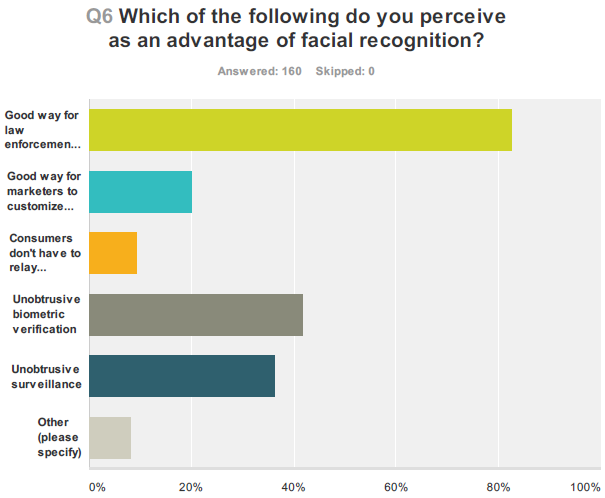What Do People Really Think About Facial Recognition?
Categories: Blog
By Paul Schuepp
It’s often helpful to step outside the bubble in which we operate, because it helps us understand the views of “real people.” You know, the ones who don’t work down the hall and already know everything there is to know about your company and products.
That’s why, together with Acume Forensics of Leeds, U.K., we recently conducted a survey about facial recognition. We wanted to better gauge knowledge not only of different facial biometric techniques but also familiarity with our product that is catching on in law enforcement, ForensicaGPS.
In a nutshell, we confirmed that the public needs to be educated not only about Animetrics products but about facial recognition. This would have a positive impact on the industry and also clear up common misperceptions about the technology.
The online survey garnered 160 responses across a range of industries. The biggest: law enforcement (21%), science (19%), defense/intelligence/private security/surveillance (15%), biometrics (7.5%), and IT/software development (6%).
This is no surprise since the vast majority of face recognition technology today is used by law enforcement and security professionals to identify criminals. In the commercial sector, companies of all types are examining the technology for personalization, authentication, entertainment and other uses.
In terms of familiarity with facial recognition, 32.5% said they were thoroughly or very familiar with it, while 46% proclaimed to be somewhat familiar.
Respondents said they were most familiar with a feature-based facial recognition technique, followed by 2D-3D analysis, a holistic approach, texture-based techniques and 3D sensor based approaches. As noted in the chart below, the majority of respondents said facial recognition’s biggest advantage was in aiding law enforcement identify criminals.

We also wanted to know about perceived disadvantages to facial recognition. Most (43%) said “loss of privacy” followed by “technology not accurate enough to be useful” and the perception that facial recognition systems are “easily fooled.”
Fourteen percent chose “other” to this question, and we wanted to know more. We discovered that many people believe the biggest disadvantage was that the technology is ineffective in uncontrolled environments. An uncontrolled image environment is one in which the subject’s face is turned, blurred or otherwise obscure, compared with a “controlled” environment such as a picture taken at the DMV or a passport photo.
For Animetrics, this is a case of good news/bad news. The bad news is that it shows we can do a much better job educating the public about our solutions.
The good news is that our hottest product, ForensicaGSP, does just that: it fixes a lot of the problems of uncontrolled images and corrects them to increase the likelihood of a positive match. ForensicaGPS converts a 2D facial image into a 3D avatar that can be rotated and viewed from any angle.
This is a powerful tool for forensic investigators.
Also encouraging; a near majority of respondents said that 2D to 3D transformation, and pose correction are top features that would be most helpful in establishing a positive identification.
Guess what? That’s exactly what ForensicaGPS is all about!
Use of facial recognition, even in law enforcement, is still in the early stages. There is a lot that we can do at Animetrics to educate the public about the technology, what it is, what it isn’t, and what it can and can’t do. Our recent webinar, in which drew over 200 registrants, is proof there is a need for education and a genuine interest in facial recognition.
Stay tuned as we continue to not only update our products with groundbreaking features but also to drive an education campaign that we hope will make facial recognition more pervasive…and better understood.

No comments yet.